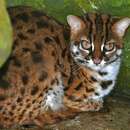en
names in breadcrumbs


The Leopard Cat (Prionailurus bengalensis) has the broadest geographic distribution of all small Asian felids. These cats are found from southern India to the islands of the Sunda Shelf and north to the Russian Far East (the Leopard Cat is one of only a handful of felid species that can be found on islands in East Asia and the only one to occur even on several small islands; Watanabe 2009). Leopard Cats are the only wild felids occurring in Japan or the Philippines. Leopard Cats are found in a wide range of forest types from lowland tropical evergreen rainforest and rubber and oil palm plantations at sea level to moist temperate broadleaf and dry coniferous forests in the Himalayas at 3000 m. They also do well in successional habitats, shrub forests, and farmlands and on coastal islands. They are generally absent from cold steppe grasslands or arid areas. Their small feet are not well suited for moving in deep snow and they consequently avoid areas where snow depth exceeds 10 cm.
Leopard Cats feed on a variety of small prey, including rodents, reptiles, birds, amphibians, crabs, and insects. They are excellent swimmers and captive animals spend a lot of time playing in the water.
These cats are heavily hunted for their pelts in many parts of their range and, as a result, although still common over most of their range, Leopard Cats may be at risk of extinction in India, Thailand, and Bangladesh. China has set an annual harvest quota of 150,000 individuals, but the number actually taken is likely larger than this. Chinese fur companies are said to have hundreds of thousands of Leopard Cat pelts stockpiled in their warehouses. Leopard Cat coats are often sold in Nepal and Kashmir.
(Sunquist and Sunquist 2009 and references therein)